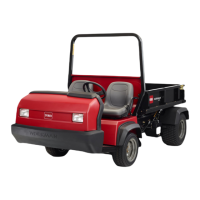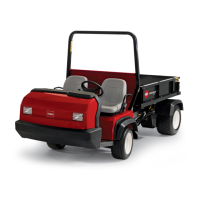Workman HD SeriesPage 8 -- 32Electrical System
Battery Charging
To minimize possible damage to the battery and to allow
the battery to be fully charged, the slow charging method
is presented here. This charging method can be accom-
plished with a constant current battery charger which is
available in most shops.
CAUTION
Follow the battery charger manufacturer’s
instructions when using a battery charger.
NOTE: Using specific gravity of the battery cells is the
most accurate method of determining battery condition.
1. If battery filler caps are removable, check the electro-
lyte level in each cell. If the level is below the tops of the
plates in any cell, fill all cells with distilled water so that
plates are just covered with electrolyte.
2. Determine the battery charge level from either its
open circuit voltage or specific gravity (if filler caps are
removable).
Battery Charge
Level
Open Circuit
Voltage
Specific
Gravity
100% 12.68 1.265
75% 12.45 1.225
50% 12.24 1.190
25% 12.06 1.155
0% 11.89 1.120
3. Determine the charging time and rate using the bat-
tery charger manufacturer’s instructions or the fol-
lowing table.
Battery
Reserve
Battery Charge Level
(Percent of Fully Charged)
(Minutes)
75% 50% 25% 0%
80 or
less
3.8 hrs
@
3amps
7.5 hrs
@
3amps
11.3 hrs
@
3amps
15 hrs
@
3amps
81 to 125 5.3 hrs
@
4amps
10.5 hrs
@
4amps
15.8 hrs
@
4amps
21 hrs
@
4amps
126 to
170
5.5 hrs
@
5amps
11 hrs
@
5amps
16.5 hrs
@
5amps
22 hrs
@
5amps
171 to
250
5.8 hrs
@
6amps
11.5 hrs
@
6amps
17.3 hrs
@
6amps
23 hrs
@
6amps
above
250
6hrs
@
10 amps
12 hrs
@
10 amps
18 hrs
@
10 amps
24 hrs
@
10 amps
CAUTION
Do not charge a frozen battery because it can ex-
plode and cause injury. Let the battery warm to
60
o
F (15.5
o
C) before connecting to a charger.
Charge the battery in a well--ventilated place to
dissipate gases produced from charging. These
gases are explosive; keep open flame and e lec-
trical spark away from the battery. Do not smoke.
Nausea may result if the gases are inhaled. Un-
plug the charger from the electrical outlet before
connecting or disconnecting the charger leads
from the battery posts.
4. Following the battery charger manufacturer’s
instructions, connect the charger cables to the battery.
Make sure a good connection is made.
5. Charge the battery following the battery charger
manufacturer’s instructions.
6. Occasionally check the temperature of the battery
electrolyte. If the temperature exceeds 125
o
F (51.6
o
C)
or the electrolyte is violently gassing or spewing, the
charging rate must be lowered or temporarily stopped.
7. Three hours prior to the end of the charging, measure
the specific gravity of a battery cell once per hour. The
battery is fully charged when the cells are gassing freely
at a low charging rate and there is less than a 0.003
change in specific gravity for three consecutive read-
ings.
8. If battery filler caps are removable, check the electro-
lyte level in each cell. Adjust electrolyte level if needed.

